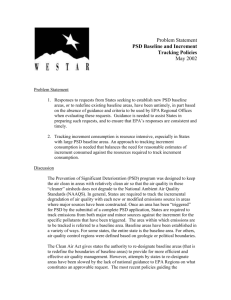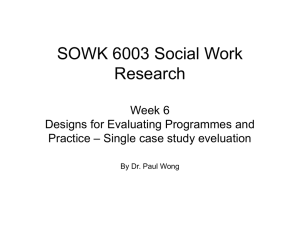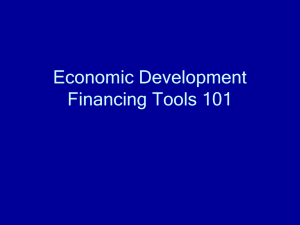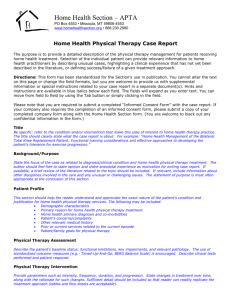RANDOM BACKGROUND ON PSD
advertisement
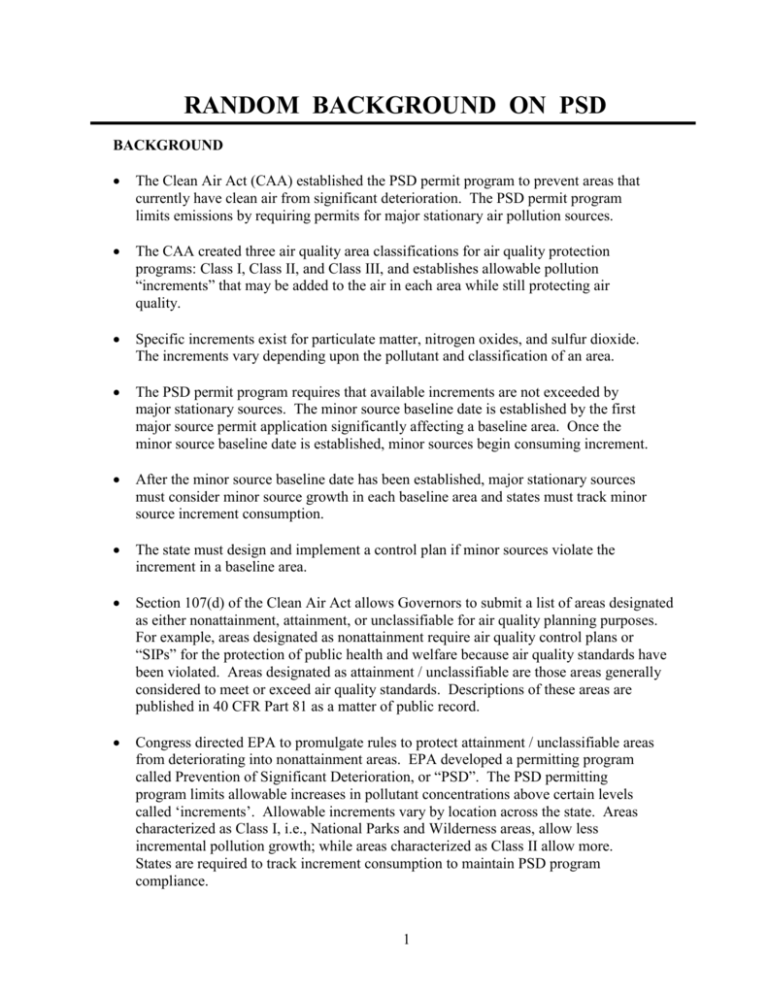
RANDOM BACKGROUND ON PSD BACKGROUND The Clean Air Act (CAA) established the PSD permit program to prevent areas that currently have clean air from significant deterioration. The PSD permit program limits emissions by requiring permits for major stationary air pollution sources. The CAA created three air quality area classifications for air quality protection programs: Class I, Class II, and Class III, and establishes allowable pollution “increments” that may be added to the air in each area while still protecting air quality. Specific increments exist for particulate matter, nitrogen oxides, and sulfur dioxide. The increments vary depending upon the pollutant and classification of an area. The PSD permit program requires that available increments are not exceeded by major stationary sources. The minor source baseline date is established by the first major source permit application significantly affecting a baseline area. Once the minor source baseline date is established, minor sources begin consuming increment. After the minor source baseline date has been established, major stationary sources must consider minor source growth in each baseline area and states must track minor source increment consumption. The state must design and implement a control plan if minor sources violate the increment in a baseline area. Section 107(d) of the Clean Air Act allows Governors to submit a list of areas designated as either nonattainment, attainment, or unclassifiable for air quality planning purposes. For example, areas designated as nonattainment require air quality control plans or “SIPs” for the protection of public health and welfare because air quality standards have been violated. Areas designated as attainment / unclassifiable are those areas generally considered to meet or exceed air quality standards. Descriptions of these areas are published in 40 CFR Part 81 as a matter of public record. Congress directed EPA to promulgate rules to protect attainment / unclassifiable areas from deteriorating into nonattainment areas. EPA developed a permitting program called Prevention of Significant Deterioration, or “PSD”. The PSD permitting program limits allowable increases in pollutant concentrations above certain levels called ‘increments’. Allowable increments vary by location across the state. Areas characterized as Class I, i.e., National Parks and Wilderness areas, allow less incremental pollution growth; while areas characterized as Class II allow more. States are required to track increment consumption to maintain PSD program compliance. 1 For increment tracking purposes, the PSD permitting program creates “baseline areas,” which are those areas of modeled 1µ/m3 impact for a major stationary source locating in an attainment / unclassifiable area. States are required to track increment consumption in these baseline areas. EPA interprets baseline areas as those defined as attainment / unclassifiable in 40 CFR Part 81 i.e., “Rest-of-State” designations. A baseline area is defined as an area located in an attainment / unclassifiable area in which a proposed major stationary source or modifications has a 1µ/m3 impact. MAJOR SOURCE BASELINE DATES: Actual emission increases from major stationary sources occurring after the dates below are considered to consume available increment. Actual emissions occurring before these dates are not considered to consume increment, but are captured as ‘background.’ Reference 40 CFR 52.21 (14) (i). PM-10 and SO2 --> January 6, 1975; NO2 --> February 8, 1988. MINOR SOURCE BASELINE DATES: Actual emission increases from minor stationary sources and other types of sources such as vehicle tailpipe, road dust, agricultural, etc. are not considered to consume increment until the major source baseline date is triggered for an area. The definition of ‘trigger’ is the date at which increment tracking must begin in a baseline area. The minor source baseline date is triggered by the first complete PSD permit application for a source which locates in, or significantly impacts a baseline area. This is determined by the first major source PSD application received by the state after the following federal baseline dates: PM-10 and SO2 -> August 7, 1977; NO2 -> February 8, 1988. NATIONAL IMPORTANT DATES: Increased emissions from major stationary sources occurring after the dates set forth below consume increment. These are dates established by rule 40 CFR 52.21 (a)(14)(i): Pollutant PM-10 Major Source Baseline Date January 6, 1975 SO2 January 6, 1975 NOx February 8, 1988 2 Emissions from minor sources consume increment after the date of submission of the first complete PSD permit application following the dates set forth below. These are dates established by rule 40 CFR 52.21 (a)(14)(ii): Pollutant PM-10 Minor Source Baseline Date August 7, 1977 SO2 August 7, 1977 NOx February 8, 1988 MONTANA IMPORTANT DATES: The major source permit submissions that established the minor source baseline date are set forth below: Source MPC - Colstrip Pollutant PM-10 Permit Application Date March 26, 1979 MPC - Colstrip SO2 March 26, 1975 NOx NOx January 10, 1990 INCREMENT BY CLASS The following shows the increments allowed over baseline concentrations in Class I areas (40 CFR 52.21): Pollutant Increment PM-10 Annual arithmetic mean 4 8 24 hour maximum SO2 Annual arithmetic mean 24 hour maximum 3 hour maximum NOx 2 5 25 2.5 Annual arithmetic mean 3 The following shows the increments allowed over baseline concentrations in Class II areas*: Pollutant Increment PM-10 Annual arithmetic mean 17 30 24 hour maximum SO2 Annual arithmetic mean 24 hour maximum 3 hour maximum NOx 20 91 512 25 Annual arithmetic mean *NOTE: Class II areas are areas not listed as Class I areas or nonattainment areas. The following shows the increments allowed over baseline concentrations in Class III areas: Pollutant Increment PM-10 Annual arithmetic mean 34 60 24 hour maximum SO2 Annual arithmetic mean 24 hour maximum 3 hour maximum NOx 40 182 700 50 Annual arithmetic mean 4
